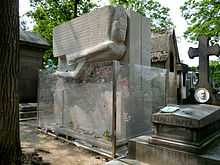Hopton Wood stone
Hopton Wood stone (sometimes Hopton-Wood stone or Hoptonwood stone) is a type of limestone quarried west of Middleton-by-Wirksworth, Derbyshire, England.[1] Described as "very fine, almost like marble"[2] and as "England’s premier decorative stone",[3] it is particularly suited to carving, making it popular for tombstones (including many thousands for the Commonwealth War Graves Commission[2][3]), sculpture and building.
Buildings and structures made using Hopton Wood stone include the Houses of Parliament,[4] Westminster Abbey, the Albert Memorial,[4] Lichfield Cathedral,[4] Calke Abbey,[4] Chatsworth House[1] and Oscar Wilde's tomb.[5]
In 1947 the Hopton-Wood Stone Firms Ltd commissioned a book about Hopton Wood stone, published by Fanfare press.[6]
References
- ↑ 1.0 1.1 "Bright Stone: Hopton Wood". British Geological Survey. Retrieved 2 May 2013.
- ↑ 2.0 2.1 "WIRKSWORTH-Parish Records 1608-1899-Hopton Stone". Retrieved 2 May 2013.
- ↑ 3.0 3.1 Thomas, Ian A. "Hopton Wood Stone – England’s premier decorative stone". England’s Heritage in Stone Proceedings of a Conference Tempest Anderson Hall, York 15–17 March 2005: 90–105.
- ↑ 4.0 4.1 4.2 4.3 "Hopton Wood Limestone". Lowes Marble and Granite. Retrieved 2 May 2013.
- ↑ Pennington, Michael (1987). An Angel for a Martyr. Whitenights Press. p. 32. ISBN 978-0704901131.
- ↑ "The Book". Retrieved 2 May 2013.
